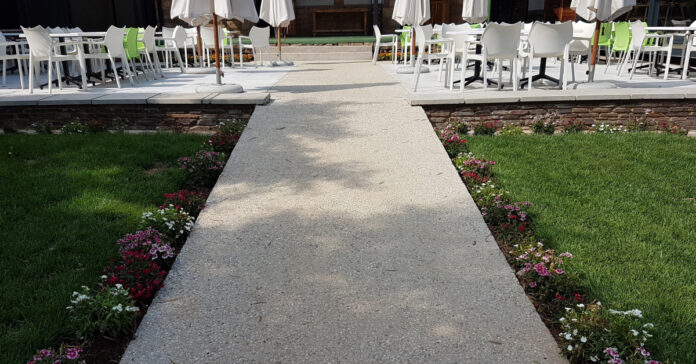AN upward trend in the use of surface retarders in South Africa’s construction and infrastructure sector is shining a spotlight on the increasing popularity of exposed aggregate concrete finishes. According to Michelle Fick of Chryso Southern Africa, this trend reflects a growing appreciation for both the aesthetic and functional benefits that exposed aggregate offers.
“Exposed aggregate is no longer just a decorative finish; it’s being adopted across a wide range of applications from pavements and driveways to architectural facades and public infrastructure,” says Fick. “The textured non-slip surface offers a safer option for high traffic zones, while the natural stone aesthetic enhances the visual appeal of buildings and outdoor spaces.”
The finish is also ideal for preparing concrete surfaces that will receive a subsequent layer. Whether it is a waterproofing membrane, screed or cladding, the roughened texture created by the exposed aggregate allows for superior bonding, improving the durability and lifespan of the entire system. This makes it a preferred solution not only in aesthetic applications but also where structural performance is key.
Chryso Southern Africa offers surface retarders designed specifically to meet these evolving needs. The company’s products facilitate reliable consistent exposure of the aggregate to the required depth – up to a maximum of 3 mm – ensuring a uniform and high quality result. This is essential for specialist applicators who rely on precision and repeatability, particularly in large-scale or architecturally sensitive projects.
“The simplicity of the application process is another advantage,” Fick explains. “After the concrete is poured, the surface retarder must be applied evenly before the concrete begins to set. Following a predetermined curing period the surface is washed with water, removing the top layer of cement paste and revealing the aggregate below. A final sealant is then applied to enhance the surface’s durability and finish.”
Sealants can be selected to suit different environments and project needs including internal and external use, UV resistance and finishes ranging from matte to high-gloss. This flexibility allows architects and contractors to customise the final appearance while ensuring long term performance.
Significantly, Chryso was the first manufacturer to offer a mineral solvent-free water-based retarder designed to prevent soil and groundwater pollution during the cleaning of treated concrete. The product contains no toxic substances, is 85% biodegradable, classified as harmless and complies with EEC Directives 88/379 and 93/18.
Fick notes that Chryso’s surface retarders are developed with the applicator in mind, offering not only technical consistency but also ease of use in site conditions that can often be challenging. “Our retarders provide reliable performance even under variable temperature and humidity conditions, which is critical for projects with tight timelines and complex environmental demands.”
With sustainability and safety continuing to drive specification choices in the built environment, the use of exposed aggregate finishes is expected to grow. “The combination of visual impact, surface durability, slip resistance and improved bonding makes it a smart choice for both new builds and renovations,” Fick concludes. “As the trend gains momentum, we are committed to supporting the market with reliable solutions that ensure consistent high quality results.”
